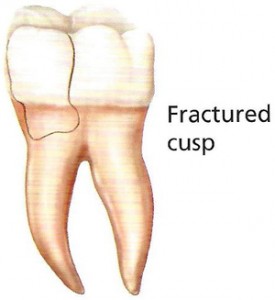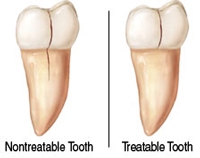Like any other damage to your teeth, a cracked tooth is going to cause pain. But depending on the kind of pain you’re experiencing, you may be able to rule in or out if you have a cracked tooth. In order to fix any problem you have to first diagnose the underlying issue. Here’s what you need to know about cracked tooth symptoms.
Whenever you have a toothache that lasts longer than a day or two, you should always schedule an appointment with your dentist. Although you might feel scared of visiting your dentist, it’s best to identify and treat a dental problem as soon as possible. It’ll probably save you money in the end, too.
What do cracked teeth look like?

Split Tooth

Fractured Cusp

Vertical Root Fracture
There are different ways a tooth can crack. This means that cracked teeth won’t always look the same. Sometimes a tooth might literally have split all the way down to the root. Other times patients can experience a lot of pain because of a crack that isn’t even visible.
How did your tooth crack?
Here are the different kinds of cracks that develop:
- Craze lines: These cracks don’t cause any problems. You might see them when you look in a mirror. But if they don’t cause you any pain, there’s no reason for concern. Craze lines aren’t cracked through a tooth’s enamel, which is why they don’t cause any discomfort.
- A cracked tooth: A regular cracked tooth isn’t usually cracked down to the root. If you don’t treat the affected tooth, however, the crack might extent further. Also, you may not even see the crack. That’s why it’s important to see your dentist when you have tooth pain, even if you don’t see any harm to your tooth.
- A vertical root fracture: This problem occurs when a tooth has split all the way down to the root. Oftentimes, you’ll need a tooth extraction if the crack extends this far.
- A split tooth: Split teeth are visibly split into two parts. But if the crack that’s splitting a tooth doesn’t extend to the root, these teeth can still be saved.
- A fractured cusp: This occurs in your molars when one of the part cracks. Sometimes it might even break off completely, leaving a large hole in your tooth.
Teeth aren’t like bones, they won’t heal if you just wait. Once a tooth has been fractured or damaged in any way, you must see a dentist in order to prevent further damage from occurring.
Cracked tooth symptoms

Cracked Teeth: Once the crack extends below the gum line, the cracked tooth can’t be saved and may need to be extracted.
One of the most obvious of cracked tooth symptoms is to actually see or feel a crack, but there are many other things to look for. Sometimes the crack will be very fine but will still go deep into the root of the tooth.
If you have tooth pain and you’ve already went to your dentist without any luck finding the problem, you might have cracked tooth syndrome. This is a condition that occurs when the crack that’s causing the pain is perhaps even microscopically small, but has gone deeper than the hard, outer layer of your tooth.
Usually a cracked tooth will cause you to have erratic pain when you’re chewing, especially when you release your bite. Other than that, a crack that’s really small could lead to an infection of the pulp inside your tooth. If that’s the case, you might even feel a pain that throbs in intensity.
Preventative treatment options for a cracked tooth
In short, preventing tooth damage is always better than treating it. Even if you do have a cracked tooth, be sure to take the necessary precautions to protect your other teeth from cracking as well. You should always wear a mouth guard while playing contact sports and avoid grinding or clenching your teeth. If you find that you grind your teeth while sleeping, you should consider getting a mouth guard to use while you sleep as well. Avoid biting into hard foods like sugar candies (lollipops, for example). And lastly, always brush your teeth at least twice daily to keep them healthy and prevent further complications.

